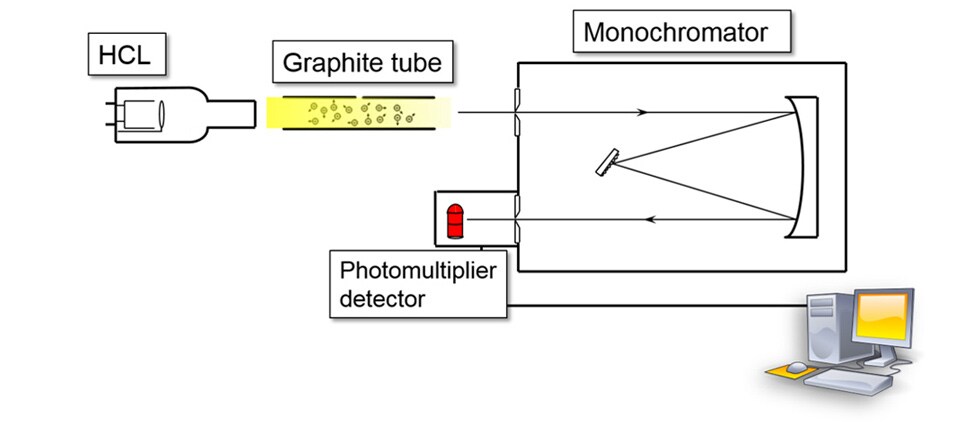Search Thermo Fisher Scientific
Atomic Absorption Spectrometry (AAS) Sample Preparation
Sample preparation and introduction involve rendering a liquid or solid sample into a state that the instrument can process for elemental analysis. In the case of flame AAS, this involves atomizing the sample, which involves the creation of a fine mist dispersion. Afterwards, this mist is fed into a flame to break up any remaining molecular bonds. This is known as atomization. In graphite furnace AAS, the liquid sample is introduced into the cuvette directly, where it is transformed into a fine mist.
The sample is then exposed to a source of radiation, which typically originates from a light source. This light source has been set to defined wavelengths, and the metal atoms in the sample absorb these wavelengths (or not). When absorption occurs, the result is a light spectrum that has reduced light intensity in one or more of its areas. This reduced intensity is characteristic of a given element and helps to identify it, as well as to determine its concentration.
AAS takes advantage of different radiation wavelengths that are absorbed by different atoms. Atomizer and monochromator instruments are key to making the AAS device work.
Afterwards, the analyte is excited by different light sources and emits a mixture of wavelengths. Following dispersion of these wavelengths (including the characteristic wavelength of the analyte), the AAS instrument detector measures wavelength intensity. Because element concentration is a function of its wavelength intensity, the concentration of the target element can be determined. Also, by establishing a reference system from standards of known concentration, unknown samples can be analyzed quantitatively.
Flame Atomic Absorption Spectrometry (FAAS)
Flame atomic absorption spectrometry (FAAS) is a globally recognized analytical technique used for analyzing over 60 elements including sodium, potassium, calcium, magnesium, zinc, and iron. It is widely accepted in many industries, which continue to utilize the unique and specific benefits of this technology.
During the analysis, liquid samples are aspirated and introduced into the flame via a spray chamber, which breaks the aspirated liquid into fine droplets. The flame is typically created using air/acetylene or nitrous oxide/acetylene gases, and this results in desolvation, vaporization, and atomization of the sample. Hollow cathode lamps emit light that is specific to the element, and this light is directed through the flame to allow for measurement during atomization. High-performance optics and precise monochromator operation ensure that the light path is always perfectly aligned for analysis.

Graphite furnace atomic absorption spectrometry (GFAAS)
Graphite furnace atomic absorption spectrometry (GFAAS) is an established analytical technology that is used for measuring a large number of elements at parts-per-billion levels, including chromium, nickel, arsenic, lead, cadmium, copper, and manganese. Sample consumption is incredibly low, and typically only a few microliters of sample are directly injected into a graphite cuvette. Controlled electrical heating of the cuvette dries the sample and removes the matrix prior to atomization. Hollow cathode lamps provide specific elemental light output, which is directed through the center of the cuvette to enable measurement during atomization.



Just like in FAAS, high-performance optics and precise monochromator operation are key to making sure that the light path is perfectly aligned.
FAAS and GFAAS sample preparation

Many different kinds of samples from diverse industries can be analyzed by using either FAAS and GFAAS following simple preparation procedures. The five major application areas are the environmental and clinical/pharmaceutical, food and beverage, mining/metallurgy, and petrochemical industries.
A typical sample preparation procedure for solid and viscous liquid samples involves digestion with a concentrated acid; for example, HNO3, HCl, or H2SO4. After dilution of the digested solutions, samples can be directly injected into flame AAS as well as graphite furnace AAS. Other sample preparation methods, including microwave and high-pressure digestion, are also used to break up samples.
Sample preparation techniques | Hot plate, microwave digestion, acid digestion, high-pressure digestion |
Acid | HNO3, HCl, H2SO4, HF, H2O2 |
Spectroscopy, Elemental & Isotope Analysis Resource Library
Learn how elements and their isotopes can provide essential molecular information at our library of applications notes, scientific posters, webinars, and more.
